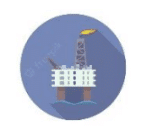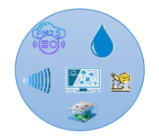What we do
What we do
The Environmental Protection Act empowers the Agency to oversee the environmental activities of all persons. The Agency is regulatory with the authority to grant or not grant permits for developmental project that will impact on the environment. As a regulator, the Agency is also required to monitor activities of development and to enforce the provisions of the Act. The work of the EPA is organized into technical programme areas, supported by the Operations and Corporate, Human Resources, Finance and Communications Departments.
Permitting and Compliance
This department underpins the core functions of the Agency; to issue environmental authorization for developmental activities, and to ensure compliance with the permit conditions. The technical programme areas also work to develop standards and guidelines for operators within the various economic sectors. The following programme areas are integral to the permitting and compliance component of the Agency’s work.

Public Infrastructure, Transportation and Tourism
The programme area is tasked with the responsibility of ensuring all infrastructure activities including construction and operational are permitted. The department also oversees environmental activities related to the tourism sector.
Projects authorized:
- Roads
- Bridges
- Wharves
- Airstrips
- Hotels
- Resorts

Mining
Given Guyana’s proactive steps taken to ensure the elimination of mercury by “2025” within the mining sector, the Agency’s Mining Unit is tasked with the responsibility of developing standards that seek to restore and reclaim mined- out lands, prevent land and water pollution. The Environmental Protection Regulations guide this team in executing the legal requirements needed for the process of authorization, compliance and enforcement.
Projects authorized:
- Diamond mining
- Sand mining
- Loam mining
- Quarries

Forestry
The Forestry Department is responsible for ensuring the development of standards that seek to restore and reclaim degraded forestry lands, prevent release of contaminants to these lands as well as to conserve and manage the associated resources.
Projects authorized:
- Logging
- Sawmills
- Lumberyards (with and without processing)
- Charcoal Production
1. The Environmental Protection Act empowers the Agency to oversee the environmental activities of all persons.
2. The Agency is regulatory with authority to grant or not grant permits for developmental project that will impact on the environment. As a regulator, the Agency is also required to monitor activities of development and to enforce the provisions of the Act.
3. The Agency is the National Focal Point (NFP) for three Multi-lateral Environmental Agreements: UN Convention of Biological Diversity, Basel Convention, and the Cartagena Convention. Its role as NFP it to coordinate activities to meet national responsibilities under these Agreements.
4. For the UN Convention on Biological Diversity (UNCBD), the Agency coordinates the preparation of National Biodiversity Reports, National Biodiversity Strategies and Action Plans, and Biodiversity Regulations. These tools also able the Agency to accomplish its responsibilities according to the Environmental Protection Act.
5. For the Basel Convention (Basel Convention on the Control of Trans-boundary Movements of Hazardous Wastes and Their Disposal) the Agency takes measures to control the import and export of hazardous waste through granting of authorization.
6. For the Cartagena Convention (Convention for the Protection and Development of the Marine Environment of the Wider Caribbean Area), the Agency coordinates activities particularly in relation to the protection of marine wildlife.
7. The Agency also promotes and public participation in relation to scoping of environmental impact assessments and encourages a better understanding and appreciation of the natural environment and its role in economic development.
8. The Agency’s work is organised into programme areas, each with a specific focus, including: Mining; Forestry; Public Infrastructure/Transportation/Tourism; Manufacturing/Industry; Oil and Gas; Agriculture, Communications; Complaints/Emergency Response; Technical Services; Policy and Planning; and Legal Services.
Slogan: “The Environment is everybody’s Business”
Regulations

Agriculture
This programme area oversees projects relative to the agricultural sector.
Projects authorized:
- Poultry rearing and processing
- Swine rearing
- Rice mills
- Aquaculture and seafood processing
- Agro-processing
- Large scale crop production

Oil and Gas
The Oil and Gas Department captures development activities within the sector and is divided into two sub-programmes which focus on upstream and downstream activities.
Projects authorized:
- Exploration Surveys
- Exploration Drilling and Production
- Crude Lifting
- Gas Stations
- Bunkering
- Fuel Storage

Industry and Manufacturing
Industry and Manufacturing was crafted based on the types and trend of projects under environmental authorization, and those potentially new projects that will be seeking authorization from the agency as the country continues to transform.
The programme area is divided into four sub-programmes:
- Medical and health facilities
- Chemicals and manufacturing
- Waste management
- The Basel Convention

Technical Services
The Technical Services Department supports the work of the other technical programme areas within the Agency, collaborates with sister agencies, and authorizes projects related to the emission of air, noise, and water.
Some of the functions of the Department include, but are not limited to:
- Conduct, promote and coordinate research concerning any aspect of pollution or prevention
- Formulate standards, guidelines and codes of practice to be observed for the improvement and maintenance of the quality of the environment and limits on the release of contaminants into the environment
- Monitor and coordinate monitoring of trends in the use of natural resources and their impact on the environment
- Advise key stakeholders on the content and applicability of environmental control instruments.
- Provide general information to the public on the state of the environment by annual reporting.
The Technical Services Programme Area also equips officers of the Agency with technical expertise in the areas of air, noise, GIS, hazardous waste, water, radiation and drone imaging and encapsulates information technology, database management, Geographic Information Systems (GIS) and research and development/analytics. The programme area also facilitates biodiversity research through the permitting of researchers.
NB: The lists of projects identified are not exhaustive.

Communications
The Communications Department is a cross-cutting programme area that underpins the work of the EPA. The Department fulfils the Agency’s role to promote public participation in relation to scoping of environmental impact assessments, and encourages a better understanding and appreciation of the natural environment and its role in economic development.
The programme area functions on the principle that environmental education is ‘education for life’. It is critical to ensuring the systems for environmental management and compliance, as well as, sustainable use of natural resources are effective. The department’s work focuses on three areas:
- Environmental awareness
- Environmental education
- Communication

Complaints
Facilities whether authorised or unauthorized will at some time, release unwanted materials into the environment, and it is the duty of the Agency to prevent and control the release of pollutants into the environment. The Complaints Department is responsible for carrying out this specific objective where several steps are taken to prevent and remedy pollution, including conducting investigations and inspections to ensure compliance with the Environmental Protection Act and regulations.
The Department also takes enforcement action when legal requirements are contravened or not complied with, requiring parties to meet their legal obligations or remedy their non-compliance. It may not always be possible to restore the environment to its previous state, so one aspect of the EP Act makes provisions in working with offenders to minimizing the extent of the damage or risks, and taking all practical and reasonable steps to remediate the impacts. The Department also works closely with other regulatory, law enforcement agencies and local authority bodies to bring operators into compliance.

Legal
EPA is empowered by the Environmental Protection Act Cap 20:05 to provide protection and management of the natural environment, coordination of conservation programs, and assessment of the impacts of developmental activities on the environment. The Legal Unit provides legal opinions, advice and support to the various programme areas of the Agency as well as, handling of all court cases. This Unit plays a critical role in reviewing and drafting of contracts, employee policies and also ensuring the appropriate conditions are reflected within permits issued.

Policy and Planning - Multilateral Environmental Agreements
The Agency is the National Focal Point (NFP) for three Multi-lateral Environmental Agreements: UN Convention of Biological Diversity, Basel Convention, and the Cartagena Convention. Its role as NFP is to coordinate activities to meet national responsibilities under these Agreements. The Department is also involved in project management,
overseeing GEF funded projects, and implementation of the coastal and marine management programme.

Policy and Planning – Public Relations
The Public Relations Officer’s task is to enhance the Agency’s image and amplified public engagement in tandem with the Executive Director and the Communications Department.

Operations and Corporate Services
The Operations and Corporate Services Department comprises the administrative operations of the Agency including transportation, logistics, security, registry, maintenance, events and public management. It also encompasses procurement, assets
and stores management.
The Central Registry ensures the secure custody, accounting and efficient processing of the voluminous amounts of documents. The Registry is the repository for all documents entering and leaving the Agency. All documentation regarding the work of the EPA in fulfilling its mandate can be accessed through the Registry. This includes
authorisations granted, enforcement and prohibition notices served, complaints received by the agency etc. All documents, projects, correspondence, applications etc. entering or leaving the Agency must be channelled through the registry.
The main responsibilities of this department are to:
1. Provide administrative and logistical support to all departments and programme
areas within the Agency;
2. Ensure materials, equipment and services meet the needs of the Agency
3. Ensure the Agency has a fleet of efficient vehicles to fulfill its transportation requirements
4. Maintain an orderly and effective record of documents entering and leaving the Agency.











